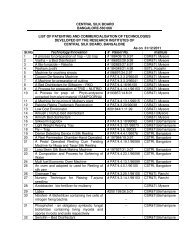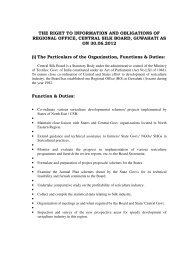You also want an ePaper? Increase the reach of your titles
YUMPU automatically turns print PDFs into web optimized ePapers that Google loves.
While organising mass communication programmes like Krishimelas, Vicharghostis,<br />
etc. they should be in consultation with the DoS and invite the local elected<br />
representatives.<br />
All institutes should submit the monthly and quarterly reports in the prescribed<br />
formats regularly along with duly filled in RFD and the same will be reviewed every<br />
month besides responding promptly to all the letters & circulars issued by the<br />
central office.<br />
Directors of the institutions should personally review and monitor all civil /<br />
construction works on a monthly basis ensuring timely submission of UCs in the<br />
prescribed formats.<br />
Any technology being filed for patenting should simultaneously be commercialized.<br />
Under no circumstances exclusive rights be given to any single party. They can use<br />
the services of NRDC for patenting and commercialisation of their products as per<br />
the MoU entered between CSB and NRDC.<br />
All the parents of the authorised silkworm hybrids must be available for commercial<br />
exploitation or any further trials leading to commercialisation. If progenitors are<br />
failed to provide seed material, such hybrids/variety will be considered for denotification.<br />
The parental breeds of all the silkworm hybrids accepted for testing under the race<br />
authorization process should be deposited to CSGRC, Hosur.<br />
Work on rain water harvest and in situ water conservation should be under taken by<br />
all non-mulberry R&D units.<br />
Large scale trail of artificial diet for Tasar and Muga silkworms should be carried<br />
out.<br />
Scaling up of indoor rearing of tasar and muga silkworms should be taken up by<br />
CTR&TI, Ranchi and CMER&TI, Lahdoigarh.<br />
One seed laboratory each may be started attached to BTSSO and MSSO/ESSO to<br />
work on burning seed related problems.<br />
It is suggested that all the breeders should invariably consult the literature/data<br />
bank developed by the CSGRC or other institutions and identify the donors for their<br />
breeding programme. There should be sharing of information among the CSGRC<br />
and other institutions while CSGRC should build up a data bank on the<br />
characteristics of the available germplasm. A workshop may be conducted to<br />
facilitate the breeders to interact with the CSGRC scientists and draw their breeding<br />
programmes considering the characteristics of the available germplasm. SBRL<br />
Kodathi will also provide information on molecular characterization, markers<br />
identified and the methodology to be used in Marker Assisted Selection.<br />
Work should be initiated on discriminating seed zones from commercial cocoon<br />
production zones, especially in non-mulberry to contain the diseases and to<br />
improve the healthy silkworm seed production.<br />
All the R&D units, seed organizations and DoS should jointly work for pebrine<br />
monitoring and management. Local task force committees should be constituted to<br />
monitor the seed crops as well as commercial crops.<br />
It is learnt that several projects are continuing for more than 15 years. This needs to<br />
be explained by the Directors of all the respective Institutes.<br />
27













